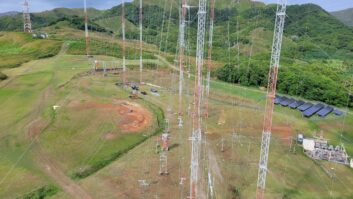Those of us who have worked in broadcast engineering for any length of time have experienced lightning damage. We have learned how to identify the difference between a strike on a tower and a surge entering the site on the power line by noting which parts of the transmitter site were damaged.
A strike on a tower may cause damage to an antenna, transmission line, lighting system or anything else mounted on the tower. If it enters the building by this route, there might be damage to the output components of the transmitter. In the case of an AM station, the antenna tuning unit could be damaged.
When a surge enters by way of the power line, the power supply components may be damaged, and also any accessories in the building using AC power. It is basic detective logic. If you have considerable experience, you probably have noticed that more damage is done by surges entering on the power. Statistically, it is far higher overall.
THE ELECTROMAGNETIC PULSE
But what causes a surge and where does it come from? If lightning strikes any overhead line including power, telephone, cable or any other conductor, it generates an electromagnetic pulse or EMP. Typically, two pulses move out from the strike point in opposite directions. They travel at nearly the speed of light, inducing similar pulses into any and all parallel conductors. In the case of three-phase power, all phases of power plus neutrals or ground wires are carrying individual EMPs.
Let’s take a look at a typical system with a strike on it.
In electric power, there are two methods to move it, known as “T and D,” for transmission and distribution. The transmission system consists of high-voltage lines carrying power from a power plant to a substation. Voltages are quite high, ranging from perhaps 69 KV up to 500 KV. At the substation, transformers lower this voltage to typically 12 to 14 KV. This service is distributed from the sub to businesses and residences, which also covers most transmitter sites. It may be three-phase or single-phase. In most cases, this is overhead service and is delivered to an on-site transformer pole normally furnished by the power company, but the facility may be alternatively fed by underground service. In either case, at this point, the customer must provide a location for the electric meter. This may be a pole, side of a building or other safe location. The electric company will provide a “drop,” which is typically 220 to 480 volts, to the meter site. Upon completion, the power company installs a meter in the meter base and you’re in business.

Fig. 1: EMP energy is shown as received in Hawaii from an H-bomb blast. When lightning strikes a distribution line, one of the two generated EMPs travels on the line, around the pole transformer on the neutral and then to the meter, entering the facility, where it does its damage.
NATIONAL DEFENSE
We hear news saying that much of our national power grid could be shut down by high-altitude nuclear bursts. Can this be true? Absolutely. When the H-bomb was tested in the Pacific some 700+ miles from Hawaii, the EMP travelled there and disrupted parts of the islands’ power system. Fig. 1 shows the extremely brief transverse electric field received in Hawaii, which was a big surprise to all. Is a lightning strike related to an EMP? Absolutely. If lightning should strike a tower several hundred feet from the transmitter building, could the EMP from it cause damage in the building? Absolutely. It could get into audio, data or telephone wires as well as any other conductors. In this age of solid state, the equipment in particular is vulnerable.
The only difference between a lightning-induced EMP and a nuclear EMP is size. The nuke is far more massive than the lightning EMP. It depends on the size of the bomb or the strike.
DUMPING THE PULSE
Many years ago, I was studying lightning prevention and ran across an interesting item. The U.S. Navy had munitions buildings that were experiencing explosions due to lightning. These were large, low buildings. The Navy decided to protect them with faraday screens. They were constructed as large grids of heavy wire above the roofs of the warehouses. They were supported by wooden poles alongside the buildings with ground wires running down the poles.
They prevented strikes on the buildings but had an unintended consequence. When struck, the EMP moved out toward the poles, but when it reached the 90-degree downturn, some of the pulse energy continued outward as a secondary strike. To solve this, they angled wires downward about 45 degrees from the pole tops to ground rods, which solved the problem.
But I just could not forget the fact that the pulse continued outward when reaching the right angle turn. Why?
At first, I assumed that this was simple inertia, the mass of the charge causing the pulse to continue in a straight line. However, a friend at San Juan College pointed out that electrons are so small that even the mass of billions would be insignificant. He explained that the EMP moving along a wire generates a powerful magnetic field surrounding it travelling at the same speed. Being a simplistic thinker, I imagine it as similar to a gigantic donut. In effect, the EMP generates its own waveguide as it travels along a wire. The effective waveguide resists turning for the EMP. When it reaches a 90-degree right angle turn, the waveguide steers it straight, leading to the secondary strikes experienced by the Navy.

Fig. 2: The magnetic “donut” illustrates the waveguide that resists a 90-degree turn. Fig. 2 shows an artist’s conception of this. How, I wondered, could I use this to dump an EMP?
Later, I observed that the drop wire from the transformer pole to the meter pole at my home made a 90-degree turn downward when it reached the pole. If the EMP energy wanted to continue in a straight line, how could I help it? Aha! I would provide a low-impedance path into the air beyond the sharp turn, but how?
It is well-known that when high voltage is induced onto a sharp pointed terminated conductor, DC current will begin to flow once the first ionization potential of the air is exceeded. This is nominally 6 to 8 KV, and happens in nanoseconds, depending on humidity, availability of free ions in the air and other factors. To support the drop wire on the meter pole, a large U-bolt projects through the pole. On the rear end are 5/8-inch Unified National Course (UNC) threads to accommodate the nut and washers on the back of the pole. These threads, 13 threads per inch, provide a convenient place to mount some kind of device. The U-bolt is in the same plane as the horizontal drop wire, so there is no significant impedance to this point.

Fig. 3: A close look at the EMPD and its stainless steel bristles. Obviously, to accommodate the momentary high energy of the EMP, the device must be rugged. Thin wires would disappear like a fuse. The device designed is called the EMPD, for electromagnetic pulse dissipater. As can be seen in Fig. 3, stainless steel rods project out the rear of the device. The EMP travels along the drop wire, through the U-bolt to the sharp stainless steel points and ejects out into the air in a big electric poof! The impedance of the air is far lower than the 90-degree turn, so most of the energy dissipates by that route instantly.
In Fig. 4, you can see the EMPD that has been in place for more than 10 years. The stainless steel rods are made of type 304 stainless steel alloy, which has a melting point of 2,500 degrees and because the plasma being ejected from them is so hot, the rod tips have exceeded that temperature protecting my residence. They are slightly rounded but perfectly functional.

Fig. 4: An EMPD is shown mounted on a power pole. Because transmitter sites typically are located in isolated places, they are particularly vulnerable to EMPs entering them on power wires. This simple device could eliminate a lot of damage from your future. Installation requires only a ladder and a 1-inch open-end or adjustable wrench. Obviously, there will be variations at each site, but a little ingenuity can solve any problem. If AC power enters the property, an EMP can enter by the same route. Dump it!
AFTERMATH
Since writing this article, I discovered something interesting concerning the discharge of the energy from the sharp points.
The monsoon season is upon New Mexico, so there is much atmospheric electricity to observe. I own an Intracloud Lightning Detector made by Airborne Research Associates. It is a model M-10 and is quite a sensitive device. If one observes lightning through a window while it is raining, this device can detect the discharge of individual raindrops striking the glass. Every raindrop and snowflake carries an electric charge, which transfers to the glass upon striking it. The M-10 hears it. The solution is to go out and stand in the rain while making observations. You won’t melt.
While searching the sky for intracloud discharges, I swept the device past the EMPD connected to the neutral of my power wires and was surprised to hear a sudden strong burst. The bursts repeated at intervals, confirming the first observation. There is also a 48-foot communications tower on my property that holds an Internet node for a friend. It holds two Nott Ltd. GS-2s side-mounted near the top. The M-10 detected emissions from the tips of the wires of the GS-2s. But why, I wondered, would I hear the discharges as tiny bursts?
Aha! The current discharge from the tips of the wires is not a continuous flow, but a series of discharges from the wires. It is analogous to a relaxation oscillator in which the voltage builds to a certain point, discharges by a device such as a neon bulb, and then starts the cycle over and over again. If it could be observed on an oscilloscope, it would be a classical sawtooth waveform. The voltage gradually builds until it reaches the first ionization potential of the air at the sharp point, discharges suddenly and then rebuilds repeatedly.
It took me more than 40 years to understand how charge dissipation works. It is good for one’s humility.
Ron Nott is founder of Nott Ltd., a communications equipment and service company.
RECIPE FOR MAKING YOUR OWN ELECTROMAGNETIC PULSE DISSIPATER
Ingredients:
• A 12-inch hexagonal aluminum rod (6061-T6) that is 1 inch across flats
• A quantity of 1/8-inch diameter, type 304 stainless steel alloy rods, of mixed length between 12 and 18 inches, sharpened at one end
• Package J-B Weld epoxy
• Metal cutting lathe; tap for 5/8 UNC
The body of the EMPD is a hexagonal aluminum rod (6061-T6) that is 1 inch across flats. It is 12 inches long. One end is drilled and tapped to accommodate 5/8 UNC (Unified National Course) female threads at least 1 inch deep (this is a universal thread size for most power companies; it is 13 threads per inch). The other end is drilled 3/4-inches diameter about 2 inches deep. (These operations are best performed in a metal cutting lathe). The 1/8-inch diameter stainless steel rods vary in length from about 12 inches up to 18 inches. As many rods as possible (unsharpened end) are inserted into the 3/4-inch diameter hole with short rods around the periphery and longer ones toward the center. The rods are held in place with epoxy glue; we use J-B Weld. After the epoxy is cured thoroughly (at least overnight), they are bent outward in the form of a foxtail.
Bear in mind that occasionally there may be a very powerful EMP that must be discharged. This demands that we use quality materials in construction. Lightweight, flimsy materials may be destroyed.
The purpose of the threaded hole in the end of the aluminum hex rod is so that it may be screwed onto a meter pole eyebolt. In most cases, the meter pole belongs to the property owner, but you must get permission from the power company to install an EMPD on any of their poles and their employees must perform the work.
There are many variations in the method of termination of the secondary drop from the power pole and ingenuity may be required to install an EMPD. The important thing is that the orientation of the EMPD absolutely must be in the same plane as the incoming wire (see main story). For assistance, contact Nott Ltd. (nottltd.com).












